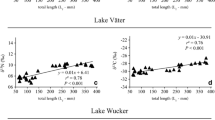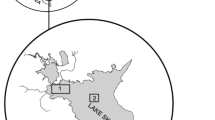Summary
Densities of the cladoceran, Holopedium gibberum, were manipulated in 18 enclosures containing juvenile (age 0+) yellow perch (Perca flavescens) and mean-lake densities of other zooplankton. In enclosures, where nearlake densities of all zooplankton species including Holopedium were maintained, young-of-the-year perch grew significantly heavier and longer than in experimental enclosures where Holopedium was excluded. Holopedium comprised between 15–45% of the diet (wet weight) of perch in the first 2 weeks of July in the control treatment (Holopedium at or near ambient lake densities) and only 3–7% of total biomass ingested in the experimental treatment (Holopedium density selectively reduced). Predation on Holopedium decreased dramatically after the 2nd week of July in the control treatment after which Chaoborus, chironomids, and Sida became dominant prey items (by weight) of juvenile perch. These findings suggest that growth and survivorship of age 0+ perch in Precambrian Shield lakes may be coupled to Holopedium abundance. Thus, utilization of Holopedium by young-of-the-year yellow perch may affect recruitment of this species since overwintering survivorship, range of accessible prey sizes or species, and vulnerability of juvenile perch to predation by larger fish depend on body size, which is reduced when Holopedium is excluded from the diet.
Similar content being viewed by others
References
Adams SM, McLean RB (1985) Estimation of largemouth bass, Micropterus salmoides Lacepede, growth using the liver somatic index and physiological variables. J Fish Biol 26:111–126
Arts MT, Evans DO (1987) Precision micrometer for measurement of mouth gape of larval fish. Can J Fish Aquat Sci 44:1786–1791
Arts MT, Sprules WG (1987) Energy reserves of three zooplankton species from two lakes with different metal concentrations. Can J Fish Aquat Sci 44:458–466
Arts MT, Sprules WG (1988a) Evidence for indirect effects of fish predation on maternal lipid investment in Holopedium gibberum Zaddach. Can J Fish Aquat Sci 45:2147–2155
Arts MT, Sprules WG (1988b) Large Daphnia as an indicator of fish predation on another zooplankton species (Holopedium gibberum Zaddach). Verh Internat Verein Limnol 23:1685–1691
Booth DJ, Keast JA (1986) Growth energy partitioning by juvenile sunfish, Lepomis macrochirus Rafinesque. J Fish Biol 28:37–45
Clady MD (1976) Influence of temperature and wind on the survival of early stages of Yellow Perch, Perca flavescens. J Fish Res Bd Can 33:1887–1893
Craig JF (1987) The biology of perch and related fish. Timber Press, Portland, Oregon, U.S.A. pp 94–121
Crowder LB, McDonald ME, Rice JA (1987) Understanding recruitment of Lake Michigan Fishes: The importance of sizebased interactions between fish and zooplankton. Can J Fish Aquat Sci 44:141–147
De Lafontaine Y, Leggett WC (1987a) Evaluation of in situ enclosures for larval fish studies. Can J Fish Aquat Sci 44:54–65
De Lafontaine Y, Leggett WC (1987b) Effect of container size on estimates of mortality and predation rates in experiments with macrozooplankton and larval fish. Can J Fish Aquat Sci 44:1534–1543
Doyle RT, Wallace DN, Dias RK, Merriner JV (1984) Laboratory study of the swimming ability and behaviour of fish larvae. N. Y. Fish Game J 31:196–216
Drost MR (1987) Relation between aiming and catch success in larval fishes. Can J Fish Aquat Sci 44:304–315
Eckmann R, Gaedke U, Wetzlar HJ (1988) Effects of climatic and density-dependent factors on year-class strength of Coregonus lavaretus in Lake Constance. Can J Fish Aquat Sci 45:1088–1093
Fuiman LA (1983) Growth gradients in fish larvae. J Fish Biol 23:117–123
Hegyi MA (1973) Aspects of the ecology, distribution, and systematics of the genus Holopedium (Cladocera, Crustacea). Ph.D. Thesis University of Tennessee, p 92
Hoenicke R, Goldman CR (1987) Resource dynamics and seasonal changes in competitive interactions among three cladoceran species. J Plankton Res 9:397–417
Keast A (1977) Mechanisms expanding niche width and minimizing intra-specific competition in two centrarchid fishes. In: Steele MK, Wallace B (eds) Evolutionary biology, vol 10. Plenum Press, New York, N. Y., pp 333–395
Langford RR, Martin WR (1941) Seasonal variation in stomach contents and rate of growth in a population of yellow perch. Trans Am Fish Soc 70:436–440
Mathias JA, Li S (1982) Feeding habits of walleye larvae and juveniles: comparative laboratory and field studies. Trans Am Fish Soc 111:722–735
Mills EL, Confer JL, Ready RC (1984) Prey selection by young yellow perch: The influence of capture success, visual acuity, and prey choice. Trans Am Fish Soc 113:579–587
Mills EL, Widzowski DV, Jones SR (1987) Food conditioning and prey selection by young yellow perch (Perca flavescens). Can J Fish Aquat Sci 44:549–555
Nero RW (1982) A description of three nets suitable for estimating the abundance of Mysis relicta. Can Tech Rep Fish Aquat Sci 1046:iv + p 8
Newsome GE, Leduc G (1975) Seasonal changes of fat content in the yellow perch (Perca flavescens) of two Laurentian Lakes. J Fish Res Bd Can 32:2214–2221
Ney JJ, Smith Jr LL (1975) First-year growth of the yellow perch, Perca flavescens, in the Red Lakes, Minnesota. Trans Am Fish Soc 104:718–725
Nielson LA (1980) Effect of walleye (Stizostedion vitreum vitreum) predation on juvenile mortality and recruitment of yellow perch (Perca flavescens) in Oneida Lake, New York. Can J Fish Aquat Sci 37:1–19
Oliver JD, Holeton GF, Chua KE (1979) Overwinter mortality of fingerling smallmouth bass in relation to size, relative energy stores, and environmental temperature. Trans Am Fish Soc 108:130–136
Pennak RW (1978) Freshwater invertebrates of the United States. 2nd edition. New York, Wiley InterScience, xviii + p 803
Rice JR, Crowder LB, Binkowski FP (1987) Evaluating potential sources of mortality for larval bloater (Coregonus hoyii): starvation and vulnerability to predation. Can J Fish Aquat Sci 44:467–472
Ricker WE (1975) Computation and interpretation of biological statistics of fish populations. Bulletin 191 of the Fisheries Research Board of Canada. Environment Canada, Fisheries and Marine Service, p 382
Scott WB, Crossman EJ (1973) Freshwater fishes of Canada. Fisheries Research Board of Canada, Ottawa, Canada. Bulletin 184. p 966
Tessier AJ (1983) Coherence and horizontal movements of patches of Holopedium gibberum (Cladocera). Oecologia 60:71–75
Tessier AJ (1986) Comparative population regulation of two planktonic Cladocera (Holepedium gibberum and Daphnia catawba). Ecology 67:285–303
Whiteside MC, Swindoll CM, Doolittle WL (1985) Factors affecting the early life history of yellow perch, Perca flavescens. Environ Biol Fish 12:47–56
Winer BJ (1971) Statistical principles in experimental design (2nd ed.) McGraw Hill, New York
Wroblewski JS, Richman JG (1987) The non-linear response of plankton to wind mixing events—implications for survival of larval northern anchovy. J Plankton Res 9:103–123
Yan ND, Keller W, Pitblado JR, Mackie GL (1988) Daphnia-Holopedium relationships in Canadian Shield lakes ranging in acidity. Verh Internat Verein Limnol 23:252–257
Author information
Authors and Affiliations
Rights and permissions
About this article
Cite this article
Arts, M.T., Sprules, W.G. Use of enclosures to detect the contribution of particular zooplankton to growth of young-of-the-year yellow perch (Perca flavescens Mitchell). Oecologia 81, 21–27 (1989). https://doi.org/10.1007/BF00377004
Received:
Accepted:
Issue Date:
DOI: https://doi.org/10.1007/BF00377004




